Here is TechViz's annual review of the best MR/VR HMDs and AR Glasses for 2023-2024.
Professional-grade XR for various use cases
This year, two very high-end and feature-packed devices were introduced into the XR world: Varjo XR-4 and Apple Vision Pro. While the latter is not included in our Top 10 XR Headsets for Professional Use list, it definitely deserves mention for its use with TechViz’s solution, as it features a unique controller-free control system (no pun intended) and other highly-sophisticated features.
If you have questions regarding the type of headset to use (VR/MR vs AR) for your project or the best-fit model, feel free to reach out to us for an advice and to tell us about your XR-related project.
You can also find answers to some popular questions in our FAQ section.
More and more manufacturers are offering both tethered AND standalone (wireless) configurations of their devices (some even with 5G connectivity, even though these are not included in this year's overview). While a tethered setup may seem more secure for use in confidential environments, the suitability really depends on the training scenario. Tethered HMDs generally compete better in terms of graphics, tracking, and performance, but they might not always be well-suited for XR training sessions where free head movement is essential. (Download a Case Study on TechViz’s collaboration with an EU Defense client on Armored Vehicle Development and Crew Training in VR, during which wireless HMDs were employed within a setting that was maintained at 100% security compliance).
That's why most models on our list offer both tethered and wireless configurations: performance in the office and versatility on-the-go.
Some manufacturers go even further, proposing "convertibles" that can transform from a VR Headset into AR Glasses.
Please note: The list below is NOT a ranking.
Professional uses of XR may vary (from corporate training & next-gen virtual meetings to military simulations), and while some may require ultra-secure MR headsets, others may prefer a more mass-market solution for entertainment-for-business purposes (e.g., in-store product demonstrations) at a more affordable price.
The list of uses and special features is non-exhaustive and is provided by the manufacturers.
If you have doubts about which VR/MR HMD to use, don't hesitate to reach out to us and tell us about your XR-related project.
| Specs/XR HMD | Varjo XR-4 Series | HTC Vive Focus 3 | HTC Vive Pro 2 | HTC VIVE XR Elite | Meta Quest |
| Headset Type | Tethered | Standalone/Tethered | Tethered | Standalone/Tethered | Standalone/Tethered |
| Supports PC-based SteamVR Software | Yes | Yes | Yes | Yes | Yes |
| Mixed Reality support | Yes; dual 20 MP cameras (33 PPD) | No | No | Yes; full-color RGB camera | Yes; stereoscopic camera w/Full-color passthrough |
| Tracking Technology | Inside-out; SteamVR Lighthouse | Inside-out; SteamVR Lighthouse | SteamVR Lighthouse | Inside-out; SteamVR Lighthouse | Inside-out |
| Controllers | Yes | Yes | Yes | Yes | Yes |
| API Support | Varjo SDK | OpenVR & OpenXR; WaveVR | OpenVR & OpenXR | OpenVR & OpenXR; WaveVR | OpenVR & OpenXR |
| Price | Starting at $3,990 | $1,300 | Starting at $999 (version w/controllers) | $999 | $999 |
| Screen Resolution (per eye) | 3,840 px X 3,744 px (4K) | 2,448 px X 2,448 px | 2,448 px X 2,448 px | 2,448 px X 2,448 px | 1,920 px X 1,800 px |
| Field of View | 120° x 105° | 120° | 120° | 110° | 120° |
| Refresh Rate | 90 Hz | 90 Hz | 120 Hz | 90 Hz | 72-90 Hz |
| Weight | 665 g (+ headband 356 g) | 785 g | 470 g | 625 g | 722 g |
| Special Features | LiDAR & Ambient Light Sensors, gaze-driven XR Autofocus, Secure Edition (option) | Cooling system, hot-swappable battery, 3D Spatial Audio | Hi-Res certified headphones, Good heat management | Convertible (VR HMD<-->XR Glasses) | Self-Tracking Controllers, Full-color passthrough |
| Uses | Ultra-realistic Simulations, Training, Prototyping | Virtual Meetings/Design, Training Simulations, Location-based Experiences, Therapy & Rehabilitation | Demonstrations, Training, entertainment-for-business | Collaboration, Sales & Marketing Visualization, Skill-based Training | Education, Product demos, Entertainment-for-business |
VR/MR Headsets:
-
Varjo XR-4 (XR headset for superlative immersion):
We start the list with the freshest headset from Varjo, featuring a high-resolution XR display (4K per eye), the world’s first gaze-driven XR autofocus that replicates true human vision in Mixed Reality, LiDAR and ambient light sensors, plus a "Secure Edition" that offers government-grade compliance for an additional cost on top of the already premium price tag (the 4Ks aren't just in its per-eye resolution).
It is a headset for companies that require the highest level of detail and immersion and are ready to invest not only in the HMD itself but also in the associated high-performance computers. Although designed with potential uses in mind, some clients may find the absence of the possibility to go wireless a significant drawback.
Pros: Superlative immersion, gaze-driven autofocus, 4K per eye resolution, premium features like LiDAR and 3D Spatial Audio
Cons: High price tag, no possibility to go wireless, heavy
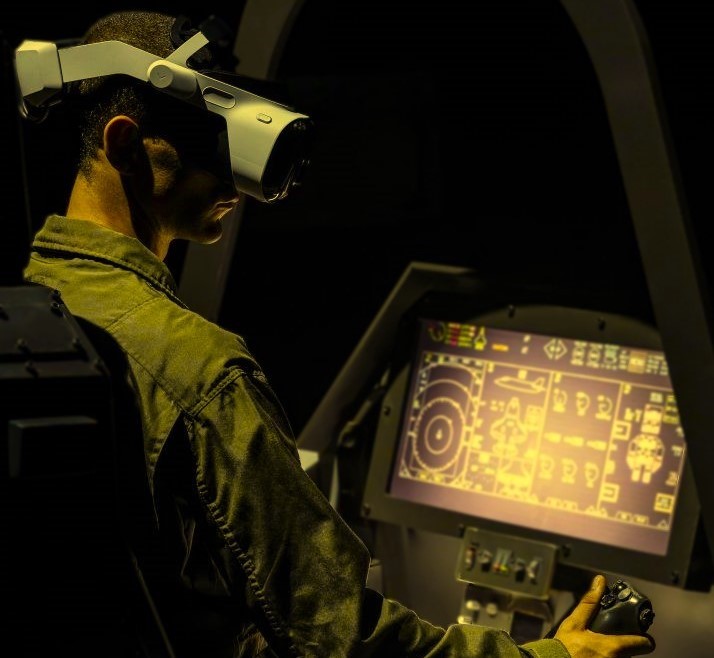
Flight Simulation with Varjo XR-4
-
HTC Vive Focus 3 (XR for Virtual Meetings and on-site projects): Next comes a headset that remained in our list since the previous year.
HTC’s Vive Focus 3 is a solid HMD suited for many professional purposes. It features a decent display resolution (5K in total, with 2,448 px X 2,448 px per eye), same field of view as the upper range competitors, swappable battery for extended use and 3D Spatial Audio as a nice bonus. A good all-arounder suited for many uses ranging from Virtual Meetings to Training Simulations and Rehabilitation & Therapy. If you don't mind spending some extra time finding its focus angle, are okay with its relative bulkiness and fan noise, then go for it for longer virtual meetings and other VR-related on-site projects without having to worry about tracking performances.
Pros: Good tracking performances, Hot-swappable battery, 3D Spatial Audio
Cons: Comfort, Difficulty to find the focus angle, Fan noise -
HTC Vive XR Elite (XR in versatile business applications): This player from HTC Vive is new to our list and comes with a special twist. A more portable version of Focus 3 more suited for on-the go scenarios due to its smaller size, it boasts a convertibility that allows one to transform it from a VR headset into AR glasses. In addition to that, they also feature a good Mixed Reality experience. It basically allows you to have a comfortable Mixed Reality headset with independent VR and AR modes, all for under the mark of $1,000.
However, it lacks both eye- and face tracking and some users find the controllers to be of mediocre quality. In addition to that, the hand tracking is not very consistent. XR Elite’s featured uses include but are not limited to sales and marketing visualization.
Pros: A true all-in-one headset (MR + VR + AR), comfortable to wear, very good video passthrough quality (for the MR part), good price given the versatility
Cons: No eye- or face tracking, hand tracking not very consistent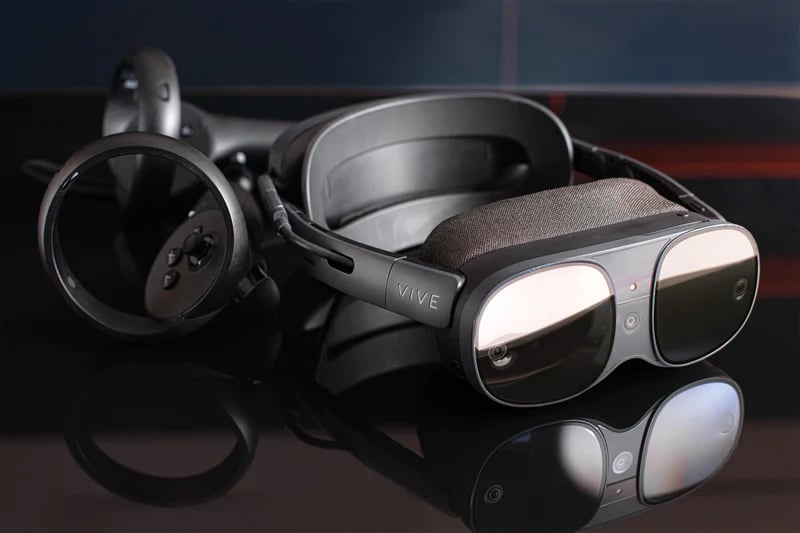
HTC Vive's "convertible" VR/MR <--> AR Headset (XR Elite)
-
HTC Vive Pro 2 (XR in high-end design and development): Another headset that remains on our list from the previous year and is the third one from the Taiwanese XR company on it.
It is praised for its exceptional audio quality and superior light-blocking capabilities compared to many other HMDs by HTC. These features, coupled with a high resolution and a refresh rate of up to 120 Hz, provide a decent immersion experience, catered to a variety of use cases.
However, unlike most other headsets on the list, it does not offer inside-out tracking. Therefore, if you are looking for an out-of-the-box portable solution, it is definitely not the HMD to go with. In addition to that, it lacks a ready-to-use standalone configuration. While an aftermarket adapter can address this issue, the wireless configuration is limited to a 90 Hz refresh rate.
To add, the HTC Vive Pro 2 supports expansive room-scale tracking, but it requires external base stations to track the movement, which can add to the setup complexity but also contributes to the precision and quality of the tracking experience.
- Meta Quest Pro and Meta Quest 3 (XR in Education): Meta has brought a pro player to the market for under $1,000. The most “Pro” side of this headset is its controllers, that offer an independent tracking mode and a realistic haptic response. The new controllers allow for users’ hands to be tracked in 360-degree mode without cameras while the TruTouch Haptics response provides a different level of tactical experience. These two features make this HMD the ideal candidate for entertainment-for-business (e.g., shopping malls) and education purposes not requiring a high level of data protection. The out-of-the box readiness to use allows the staff to easily get hold of it without special training.
The image, however, may seem grainy at times and if you are looking for a high-level data protection, look elsewhere. In essence, its suitability depends more on your intended usage rather than the inherent quality of the headset itself.
Pros: Independent 360 controllers, “Fun” haptic response, Pro device for under $1,000
Cons: Data protection issues, sometimes grainy image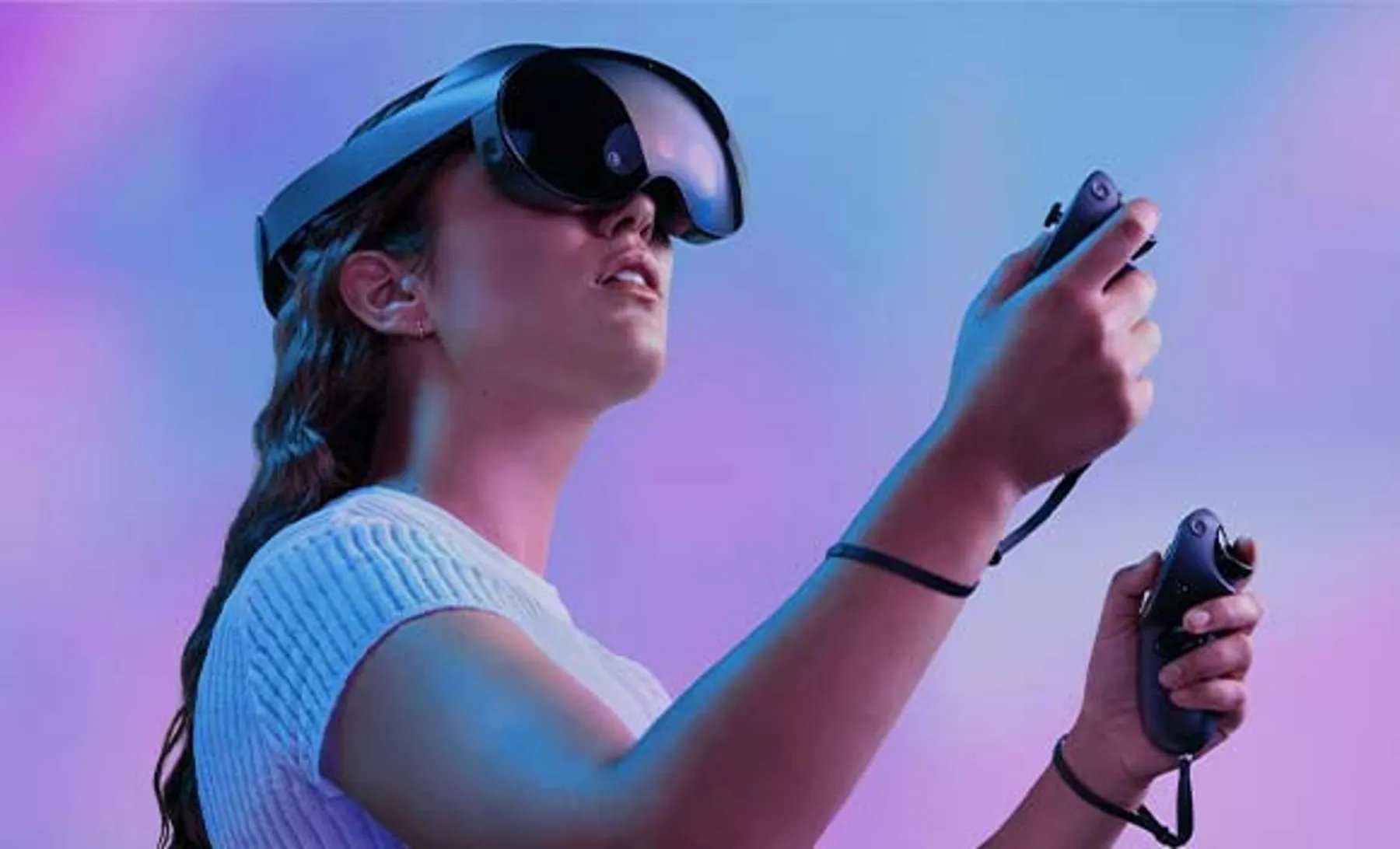
Despite featuring a new word in its name, Meta's “Pro” HMD isn’t its latest release. Its latest release is Meta Quest 3. We previously discussed the grainy image quality with the Quest Pro, and it is worth mentioning that it was especially the case with the passthrough image quality vital to ensure a high-quality Mixed Reality experience.
Meta caught up on that with its Quest 3 MR headset thanks to an additional camera used for that matter. In terms of real-world isolation, Quest 3 offers a complete one thanks to seals around the eye area. The one-year gap between the release dates has also allowed RealityLabs to feature a 33% higher refresh rate (120 Hz vs Pro’s 90 Hz) and a slightly better resolution and field of view on a device that can be afforded by small businesses.
However, the Pro version is called so for a reason and offers eye- and face tracking, crucial for some use cases as well more vivid colors thanks to its quantum dot technology with local dimming. In addition to that, its battery counterweights the front part and makes the whole HMD more comfortable to wear (a factor often overlooked yet important if you use it for more than 30 minutes). - Lenovo Think Reality VRX (XR in Industrial Training and Engineering): For those looking for a by-default enterprise-grade security option, we listed Lenovo’s VRX that possibly* allows to work on high-security projects in the military/defense sector thanks to its secure supply chain. Additionally, it provides a dual full-color passthrough feature.
However, given its potential uses, it would have been nice to have an eye-tracking technology included, which unfortunately is not the case. It is also on the heavier side being the second heaviest device after Varjo but not offering the same in terms of immersion and performances.
Pros: Enterprise-grade security, dual full color passthrough
Cons: Heavy, no face- or eye tracking
* Each defense entity autonomously determines its own risk assessment criteria and collaborates with manufacturers based on its strategic considerations, which may vary depending on the country - Apple Vision Pro: Apple’s highly-anticipated Vision Pro Mixed Reality headset doesn't make our Top 5 list simply because we were not able to get our hands on it yet. However, this “Spatial Computing” device is definitely the future of immersive technologies and deserves significant praise for its advanced features, particularly its intuitive 100% gesture control, which has immense potential for training and simulation applications.
This device marks a new era of interaction with the virtual world. Equipped with an array of sensors, including front, downward, side, as well as TrueDepth cameras, IR illuminators, and a LiDAR scanner, it tracks all user movements and positions independently, cancelling the need for external trackers or hand controllers. This independence allows for true immersion in the "computer space," as the boundary between realities vanishes when everything you look at interacts with you.
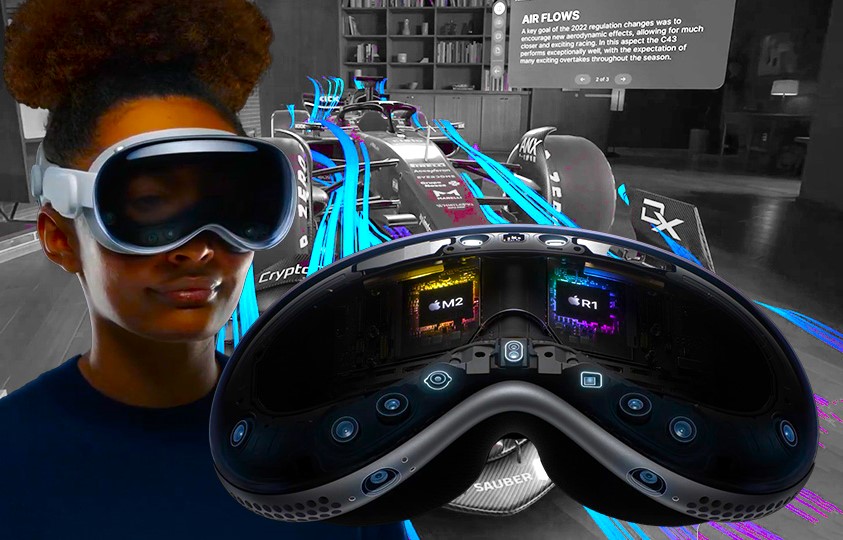
Let’s delve into its features:
Comfort & Immersion: The Vision Pro is equipped with a "Light Seal" for blocking external light, and the straps are made of super-comfortable materials.
Display: It boasts two 4K+ per eye resolution OLED displays for crisp, true-to-life colors on the inside, and an outside see-through display to maintain connection with your surroundings when complete isolation isn't required.
Processing Power: Running on the same M2 processor as some of the most advanced Macs, it flawlessly operates almost all available iPhone or iPad apps in an Extended Reality setting.
App Compatibility: Vision Pro can run most apps available on iPads and iPhones and has its own dedicated App Store for its "visionOS" operating system. Hopefully, in the future, it will also be able to run Mac apps. Restricted to Apple’s ecosystem, it nevertheless accesses a vast and advanced range of applications.
TechViz is already working to ensure compatibility of its 3D Model Visualization middleware with Apple’s Vision Pro (read the related article here : "Apple Vision Pro: A Revolution for Professionals?".
Once complete, this will allow for unprecedented immersion levels during trainings and simulations, thanks to its first-of-a-kind gesture control.
However, there are some downsides to this sophisticated device. Its premium price tag of $3,500 makes it less affordable for companies on a tighter budget. This price does not include any additional battery, which could potentially replace its external one with a 2-hour lifespan.
Pros: Superb quality & immersion, intuitive gesture- and eye-only controls, extensive sensor array, broad (Apple) app compatibility, eyeglass compatibility.
Cons: Relatively expensive, short battery life, restricted to the Apple ecosystem.
AR Glasses:
| Specs/AR Glasses | Lenovo A3 (PC Edition) | Lenovo A3 (Industrial Edition) | Microsoft Hololens 2 | XREAL Air 2 Pro | Magic Leap 2 |
| Hardware Platform | PC | Motorola G100/Edge 30 Pro | Standalone AR | PC/Mac/Tablets, etc. | PCs, cellphones |
| Software platform | Lenovo | Lenovo | Microsoft | Broad compatibility | Android 10 |
| Price | $1,499 | ~ $2,000 - $2,500 (cellphone included) | $3,500 | $449 | Starting at $3,299 |
| Screen resolution (per eye) | 1,980 px X 1,080 px | 1,980 px X 1,080 px | 1,440 px X 936 px | 1,980 X 1,080 px | 1440 px X 1760 px |
| Field of View (FOV) | 47° | 47° | 43° | 46° | Up to 70° |
| Degree of Freedom (DoF) | 6 DoF | 6 DoF | 6DoF | 3 DoF | 6 DoF |
| Refresh rate | 60 Hz | 60 Hz | 60 Hz | 120 Hz | 120 Hz |
| Weight | 130 g | 130 g | 556 g | 79 g | 260 g |
-
Lenovo Think Reality A3 (XR in Manufacturing): Lenovo’s Think Reality A3 remain our recommendation since the previous year, and for a good reason!
Highly customizable and ergonomic AR Glasses, Lenovo A3 come with a wide array of premium features such as object recognition, head- and gaze tracking. They boast eye protection compliant with (ANSI) Z87.1 standards as well as customization on tint and frame levels for a top comfort experience, whether you have a 20/20 vision or use prescription lenses.
Functionality-wise, they offer five virtual displays and room-accurate tracking.
At 130 grams, it is also a highly-portable option that can be taken anywhere where regular sunglasses can be. Despite their small weight, they are rather sturdy.
The software is made well and offers a seamless AR experience.
However, the Field of View (FOV) may not be broad enough for some use cases (e.g., reading a text while keeping the entire screen in your field of view).
In addition to that, the by-default lens tint is reported to be too dark, which may interfere with properly seeing your monitor
Pros: Five virtual displays, room-accurate tracking, high-standard-compliant eye protection, comfortable and sturdy, good software, lightweight
Cons: Expensive, Limited Field of View, dark by-default lens tint
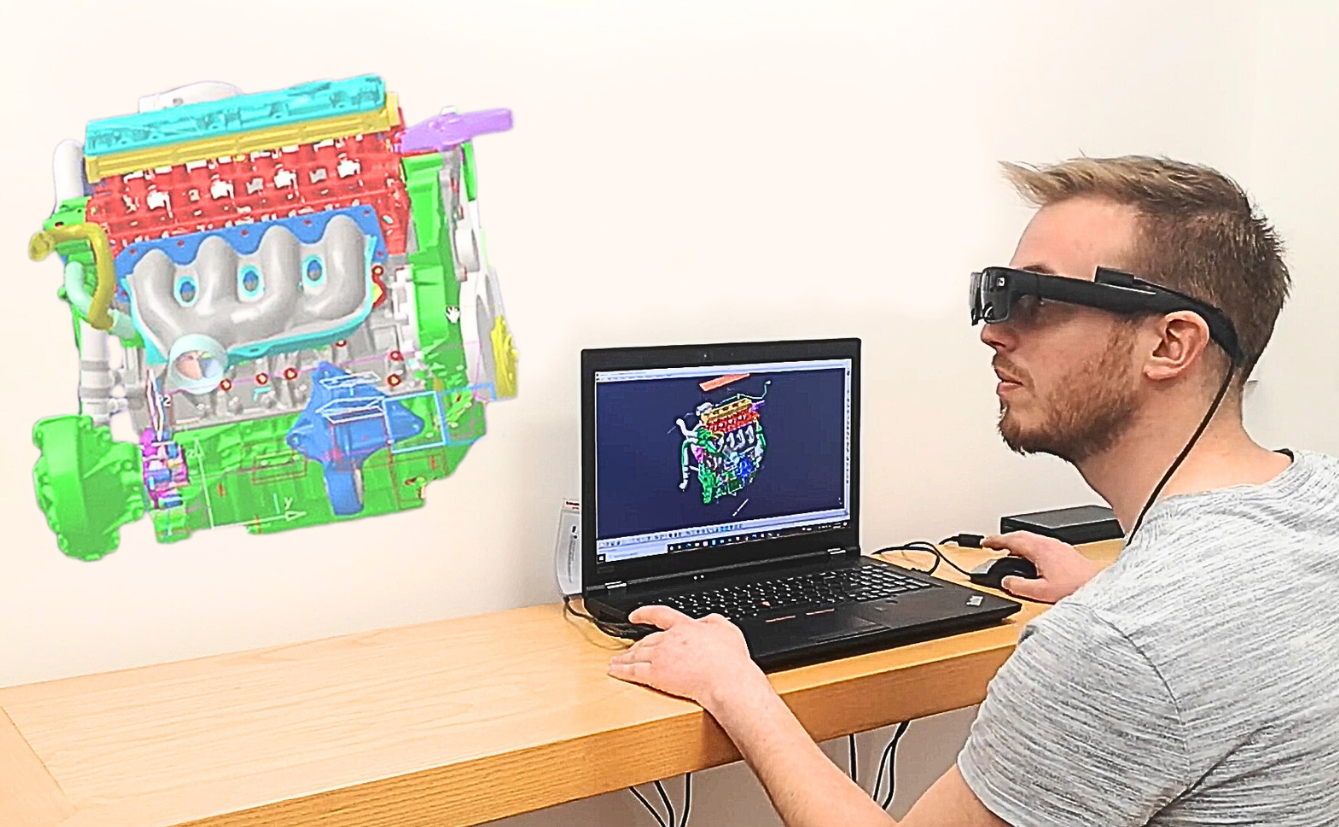
Visualizing a 3D Model in AR using TechViz's middleware
-
Microsoft Hololens 2 (XR in Industrial Maintenance and Healthcare): The HoloLens 2 is ultimately targeted at enterprises given its advanced functionalities and premium price tag. It has earned recognition and trust from entities such as NASA and Airbus, continuing to be the choice for companies that require high precision and comfort in specific settings.
It is ergonomic and made of high-quality materials.
The advanced Spatial Mapping provides the users with a detailed representation of real-world objects around the HoloLens in the Augmented Reality environment, which offers a great interaction between real and virtual elements. When you want to pause, you can comfortably prop the headset on your forehead thanks to the padding. While using the device, you can access all of the Microsoft Azure services: Cloud storage, remote rendering, AI (Artificial Intelligence), and more.
However, for a device in this price range, the inability to view screen contents in daylight conditions is disappointing. Also, while being enough for most business applications, its 60 Hz refresh rate may be a dealbreaker for companies with projects requiring a more realistic and immersive experience.
Surprisingly, despite being a Microsoft’s creation, it sometimes experiences OS bugs.
Pros: Enterprise-oriented, Spatial Mapping (PhyGital realities fusion), precision tracking, comfortable, high-quality visualization, access to MS Azure Services
Cons: Pricey, glare effect, occasional OS bugs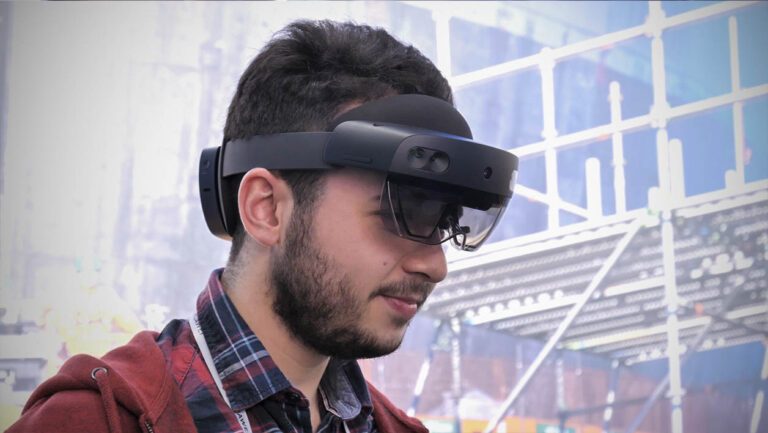
-
XREAL Air Pro 2 (XR for Interactive Media and Entertainment): This year, we've expanded our list to include the XREAL Air 2 Pro.
First of all, because it’s a more affordable alternative, which could appeal to smaller businesses. Retailing at $449, they are three times less expensive than Lenovo’s A3, yet they offer the same 1080p per-eye resolution as well as OLED displays from SONY and a 120 Hz refresh rate for a smoother immersion experience.
It's compatible with a range of peripherals, including Apple devices, and offers an instant three-monitor feature one can use with Mac running the Nebula app.
XREAL’s recent AR glasses are also on our list because of their reality-dimming feature made possible thanks to photochromic lenses. While its 500 nits make up for a pretty bright display, it is still very handy to be able to completely dim out the real world and completely focus on the content. You can also make it 35% dimmed to be aware of your surroundings.
However, despite its great features at a lower price, some users report the display corners to be blurry, which may cause problems when working with some type of content.
The audio quality is not perfect, either, which may be a dealbreaker for companies looking for AR glasses for training use.
While they offer a fixed-screen mode, where the virtual screen doesn’t move with the user’s head movements, it’s not a by-default feature and requires purchasing an additional module called Beam.
Additionally, it offers only three Degrees of Freedom (3 DoF), which is two times less compared to the six Degrees of Freedom (6 DoF) featured in previous two models from our list.
Pros: (More) affordable, OLED displays, ultra-lightweight (79 grams), 120 Hz refresh rate, reality-dimming feature, three-monitor setting, Mac compatibility, fixed-screen mode
Cons: Blurry display corners, mediocre audio quality, require add-ons for some features -
MagicLeap 2 (XR in Construction and Healthcare): If the previous model was a (more) affordable alternative for smaller businesses, this one is a competitor of Microsoft’s Hololens 2.
Having pivoted to enterprise use in 2020, Magic Leap called these AR glasses “The most immersive Augmented Reality (AR) platform for enterprise” because less than a year ago, they boasted the most powerful processor for an AR headset as well as the widest Field of View (FOV). While it is not the case anymore, it is still a remarkable pair of AR Glasses.
Its impressing 70-degrees Field of View (measured diagonally) offers a better immersive experience than the Microsoft’s AR offer. It also offers a better immersion due to the fact that its display has a better adaptability to different lighting conditions as well as crisper, higher resolution image and double refresh rate.
It puts up competition to Hololens 2’s Spatial Mapping (that it features, too) thanks to its depth sensor and full-color passthrough. The preference here depends on the use and if you are looking for more complex interactions between real and virtual objects, then Hololens 2 should be your choice as they feature AI services that improves that task. If, on the other hand, you are looking for a more seamless virtual-physical integration, Magic Leap can offer you a better experience due to the previously described depth sensor and full-color-passthrough features.
Ecosystem-wise, running on Android by Google may be better or worse than running on Microsoft depending on the user. However, Hololens 2 offer Cloud and AI enterprise integration features to its users, so Magic Leap 2 is left behind in terms of this aspect.
Using Magic Leap 2 in a healthcare setting
FAQ:
-
Are there any headsets that switch between VR and AR?
Yes, HTC XR Elite is a headset that has independent Virtual Reality and Augmented Reality modes and even offers a high-quality Mixed Reality experience. -
Which XR HMDs offer enterprise-grade security?
There are several VR Headsets that offer advanced security features, among them Varjo XR-4 and Lenovo VRX (the latter has it as a by-default option). -
Do any XR Headsets offer AI features?
The Artificial Intelligence is omnipresent these days, including in Hololens 2 AR Glasses from Microsoft. -
What is Spatial Mapping?
Spatial Mapping provides the users with a detailed representation of real-world objects around the HMD in the Augmented Reality environment.
-
How to visualize CAD models in VR?
TechViz's middleware enables engineers to visualize 3D models from more than 200 CAD/CAE apps in Virtual Reality, Augmented Reality and/or Mixed Reality on any type of XR display. -
What are the uses for Apple Vision Pro?
We expect many uses for this highly-anticipated Spatial Computing device, but one of them would be a seamless design review and training/simulation. -
Is it possible to dim the reality on AR Glasses?
Yes, some AR glasses offer gradual reality dimming. In our list, it's the XREAL Air Pro 2 (they offer a complete or a 65% reality dimming).
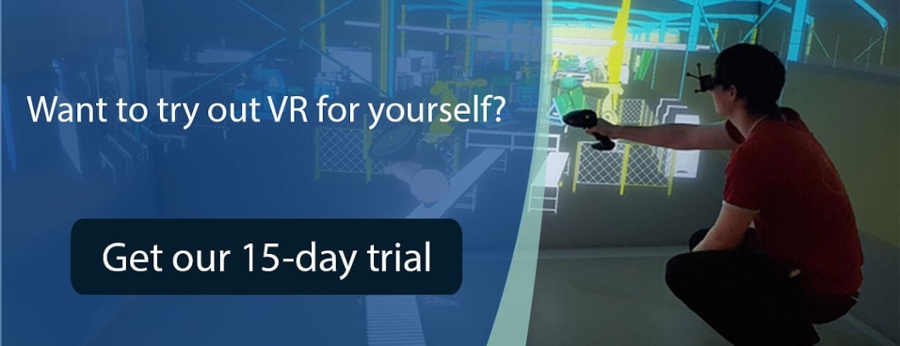






 Back to Blog
Back to Blog



